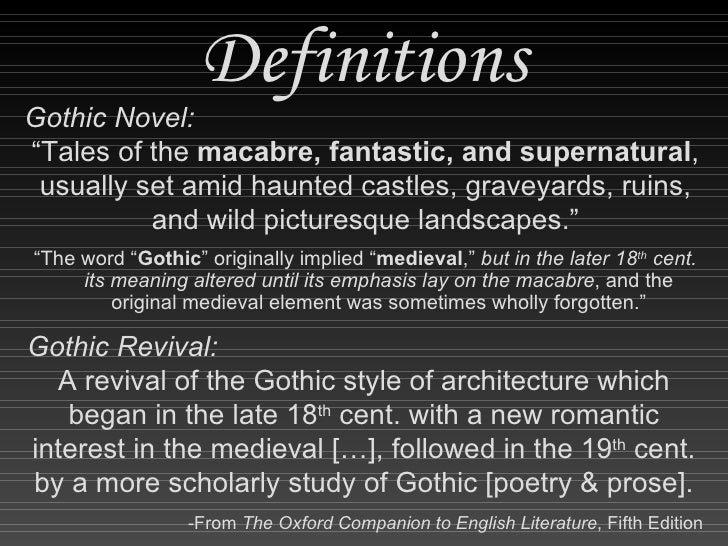

The basic plot created many other gothic staples, including a threatening mystery and an ancestral curse, as well as countless trappings such as hidden passages and oft-fainting heroines. His declared aim was to combine elements of the medieval romance, which he deemed too fanciful, and the modern novel, which he considered to be too confined to strict realism (Punter, 2004 178). For example, Horace Walpole, whose The Castle of Otranto (1764) is often regarded as the first true gothic romance, was obsessed with medieval gothic architecture, and built his own house, Strawberry Hill, in that form, sparking a fashion for gothic revival (Punter, 2004 177). It was a fascination with this architecture and its related art, poetry (such as graveyard poets), and even landscape gardening that inspired the first wave of gothic novelists. This literary genre found its most natural settings in the very tall buildings of the Gothic style - often spelled "Gothick", to highlight their "medievalness" - castles, mansions, and monasteries, often remote, crumbling, and ruined. The Castle of Otranto (1764) is usually regarded as the first Gothic novel. The stock characters of Gothic fiction include tyrants, villains, bandits, maniacs, Byronic heroes, persecuted maidens, femmes fatales, madwomen, magicians, vampires, werewolves, monsters, demons, angels, fallen angels, the beauty and the beast, revenants, ghosts, perambulating skeletons, and the Wandering Jew. Prominent features of Gothic fiction include terror (both psychological and physical), mystery, the supernatural, ghosts, haunted houses and Gothic architecture, castles, darkness, death, decay, doubles, madness, secrets, and hereditary curses. In literature such Anti-Catholicism had a European dimension featuring Roman Catholic excesses such as the Inquisition (in southern European countries such as Italy and Spain).

English Gothic writers often associated medieval buildings with what they saw as a dark and terrifying period, characterized by harsh laws enforced by torture, and with mysterious, fantastic, and superstitious rituals. The ruins of gothic buildings gave rise to multiple linked emotions by representing the inevitable decay and collapse of human creations-thus the urge to add fake ruins as eyecatchers in English landscape parks. In a way similar to the gothic revivalists' rejection of the clarity and rationalism of the neoclassical style of the Enlightened Establishment, the literary Gothic embodies an appreciation of the joys of extreme emotion, the thrills of fearfulness and awe inherent in the sublime, and a quest for atmosphere. Gothic literature is intimately associated with the Gothic Revival architecture of the same era. Melodrama and parody (including self-parody) were other long-standing features of the Gothic initiated by Walpole. The effect of Gothic fiction feeds on a pleasing sort of terror, an extension of Romantic literacy pleasures that were relatively new at the time of Walpole's novel. As a genre, it is generally believed to have been invented by the English author Horace Walpole, with his 1764 novel The Castle of Otranto. Gothic fiction (sometimes referred to as Gothic horror) is a genre of literature that combines elements of both horror and romance. Strawberry Hill, an English villa in the " Gothic revival" style, built by seminal Gothic writer Horace Walpole


 0 kommentar(er)
0 kommentar(er)
